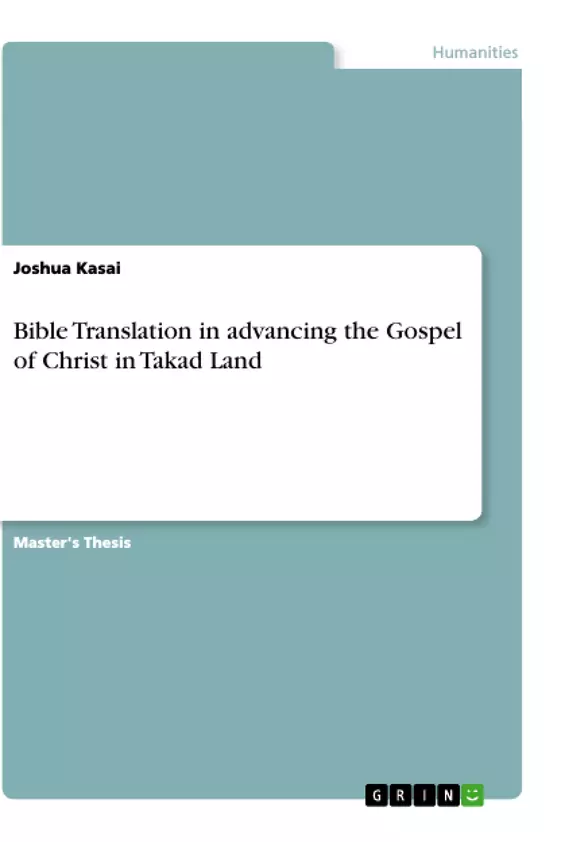This paper is about the contribution of Bible translation in advancing the gospel of Christ in Takad land. The study aims primarily at Bible translation as a foundation for Christian mission and learning, which the use of mother tongue has been said to be more impactful.
In the study, it was found out that from the original language, there has been a long history with various reasons for advancing Bible translation that were either genuine or non-genuine, ranging from reading the word of God; the necessity of preserving the religious legacy; educational need to selfishness. In particular, since the 19th and 20th century, the significance of the Bible translation in driving mission work worldwide especially the tertiary version increasingly became indisputable among the relevant stakeholders.
It was also found out that nothing is more important than one to hear the wonders of God in a language that speaks to one’s heart, the mother tongue, a confirmation of how Pentecost was accepted. The study of the Takad project strongly revealed that lack of understanding of scripture by the language speakers has been a hindrance to the growth of the gospel.
Furthermore, the use of a secondary language such as Hausa or English in communicating the gospel to the Takad language speaker has not been effective, as the gospel message is not fully understood.
The study revealed that adopting the Takad Bible will not only enhance the advancement of the gospel in Takad land, it will also serve as a foundation of learning the Takad language by the various Takad dialects.
Inhaltsverzeichnis (Table of Contents)
- I. INTRODUCTION
- Background of the Study
- Statement of the Problem
- Purpose of the Study
- Research Questions
- Significance of the study
- Structure of the research proposal
- Scope and Delimitations of the Study
- Limitation of the study
- Definition of Terms
- Conclusion
- II. LITERATURE REVIEW
- Introduction
- The concept of Bible translation
- A historical overview of Bible Translation
- Mother tongue and Bible Translation in Nigeria
- Bible translation as a strategy in advancing the gospel
- Ways of sustaining the Bible Translation strategy
- Challenges of Bible Translation
- The importance of language
- Bible translation and culture
- A brief historical development of Takad land
- Theoretical framework in Bible Translation
- Conclusion
- III. METHODOLOGY
- IV. DATA PRESENTATION AND ANALYSIS
- Introduction
- Presentation of the field findings and analysis
- Conclusion
- V. SUMMARY, RECOMMENDATIONS AND CONCLUSION
- Introduction
- Summary of the Major Findings on the Study
- Conclusion
- Recommendations
Zielsetzung und Themenschwerpunkte (Objectives and Key Themes)
This study investigates the role of Bible translation in promoting the gospel of Christ in Takad land. The research focuses on the impact of using the Takad language for scripture, highlighting the importance of mother tongue in understanding and internalizing religious messages.
- The importance of Bible translation in advancing the gospel.
- The impact of using the mother tongue in religious learning.
- The specific challenges of Bible translation in Takad land.
- The role of language in understanding and internalizing religious messages.
- The potential of a Takad language Bible to enhance cultural understanding and social cohesion.
Zusammenfassung der Kapitel (Chapter Summaries)
The introductory chapter presents the context of the study, outlining the research problem, objectives, and methodology. Chapter II delves into a comprehensive literature review, exploring the theoretical framework for Bible translation, its historical development, and its impact on religious missions in Nigeria. The methodology chapter outlines the research design, data collection methods, and ethical considerations. Chapter IV presents the analysis of the field data collected. The final chapter, which is excluded from this preview, summarizes the major findings, offers recommendations, and presents the conclusion.
Schlüsselwörter (Keywords)
This study revolves around the core concepts of Bible translation, mother tongue, religious mission, language, culture, and the specific context of Takad land in Kaduna State, Nigeria. It explores the impact of Bible translation on the advancement of the gospel and examines the importance of understanding religious messages in the native language.
- Quote paper
- Joshua Kasai (Author), 2019, Bible Translation in advancing the Gospel of Christ in Takad Land, Munich, GRIN Verlag, https://www.grin.com/document/1181560



